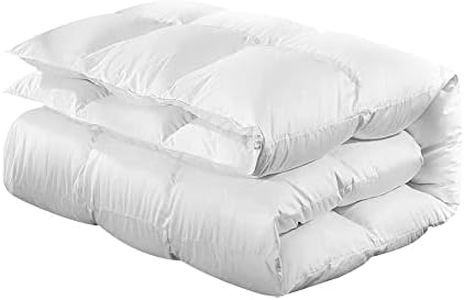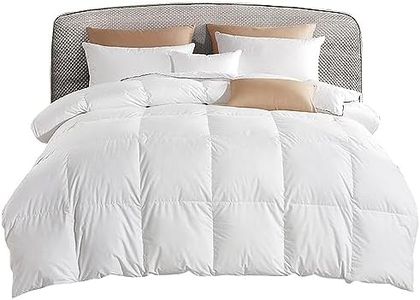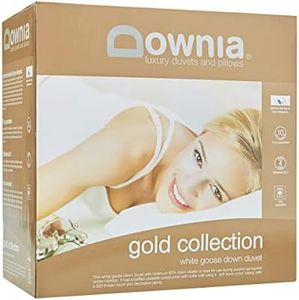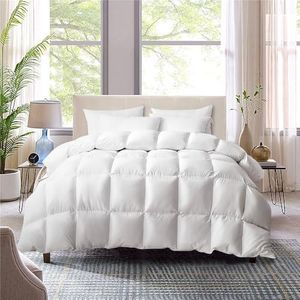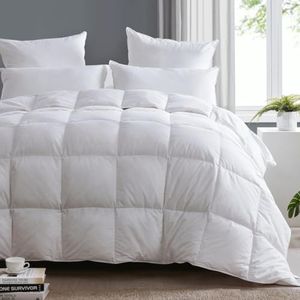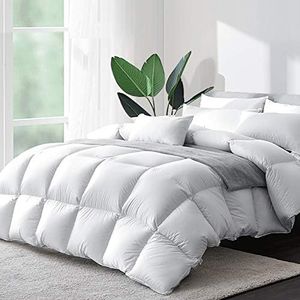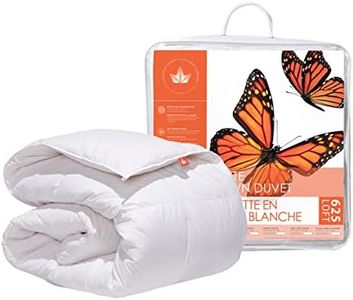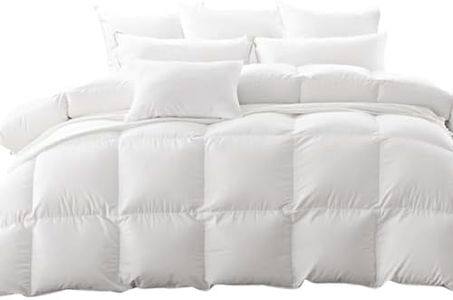We Use CookiesWe use cookies to enhance the security, performance,
functionality and for analytical and promotional activities. By continuing to browse this site you
are agreeing to our privacy policy
10 Best Goose Down Comforters
From leading brands and best sellers available on the web.Buying Guide for the Best Goose Down Comforters
Choosing the right goose-down comforter can make a big difference in how comfortable and restful your sleep will be. With a variety of options available, it's important to focus on the factors that match your climate, sleeping habits, and personal comfort needs. Consider your local weather, whether you tend to sleep hot or cold, and if you prefer something lightweight or more enveloping. By understanding the main specifications, you’ll be well-equipped to find a comforter that’s just right for you.Fill PowerFill power measures how much space one ounce of down occupies, which relates directly to its fluffiness and insulating ability. Higher fill power means larger, loftier clusters of down, offering greater warmth without extra weight. Fill power usually ranges from about 400 to 900. Comforters with a fill power of 400–600 are considered medium and good for warmer climates or for those who sleep hot. Those with 600–800 provide more insulation and are great for moderate to colder climates or for those who need extra warmth. Anything above 800 is considered luxury and very warm, suitable for very cold environments. Pick a fill power according to how cold it gets where you live and how much warmth you personally need at night.
Fill WeightFill weight refers to the actual amount of down inside the comforter, usually measured in ounces or grams. While fill power tells you about fluffiness and warmth potential, fill weight lets you know about the comforter’s overall heft and warmth. Heavy fill weights with a high fill power create very warm comforters, while lighter fill weights are better for summertime or people who get hot at night. If you want a lightweight option for mild seasons, look for lower fill weight; for chilly winters or if you get cold easily, seek out comforters with higher fill weight.
Down Type and OriginGoose down comes from the soft under-feathers of geese, and its origin can affect quality and warmth. Some regions are known for producing larger down clusters, often preferred for their insulating abilities. You might also come across duck down as an alternative, which tends to be less expensive but may have slightly different insulating properties. Goose down is generally lighter and warmer. Decide between goose or duck down based on how warm you need your comforter to be and your preference for loft and softness.
Construction (Baffle Box vs. Sewn-Through)The construction of a comforter affects how the down is distributed inside. Baffle box comforters have internal fabric walls that keep the down evenly spread out, preventing cold spots and maintaining more loft and warmth. Sewn-through constructions, where the top and bottom layers are stitched directly together, are usually lighter and less expensive, but can sometimes result in the down moving around or flattening. If you want maximum consistent warmth, especially in cooler climates, baffle box is a better choice; if you favor lightweight and more budget-friendly options for mild temperatures, sewn-through might suit you.
Fabric Shell MaterialThe outer fabric of the comforter, often called the shell, is typically made from cotton, but you might also find microfiber or blends. Cotton is breathable and often feels softer, especially at higher thread counts, while synthetic shells can be more durable or allergy-friendly. Higher thread counts make the shell softer and more tightly woven, helping to keep the down inside. Choose a shell material that feels good to you, considering breathability for hot sleepers, or tightly woven shells if you’re concerned about down leaking out.
Hypoallergenic and Cleaning FeaturesSome goose-down comforters are specially washed to reduce allergens, or are made with materials designed to resist dust mites and mold. Not all down is hypoallergenic, so if you have allergies, look for this feature. Also consider whether the comforter is machine washable or requires dry cleaning, which affects how easy it will be to maintain over time. If you’re sensitive to allergens, look specifically for certified hypoallergenic products and check care instructions to ensure it matches how much effort you want to spend on cleaning.
Size and Weight PreferencesGoose-down comforters come in several sizes, such as twin, full, queen, and king, so it’s essential to pick one that fits your bed properly and fits your sleeping habits. Some people like an oversized comforter for extra coverage or a tailored fit for a neater look. The physical weight of a comforter, aside from fill weight, can also be a comfort factor: some enjoy a heavier feel, while others prefer lightness. Consider your bed size and whether you sleep alone or share the bed, as well as what kind of body feel you enjoy when picking size and weight.
